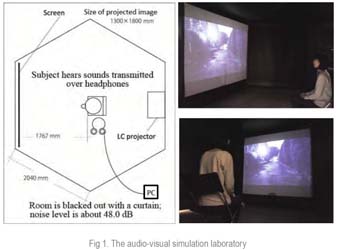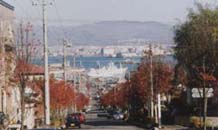|
 The effects of acoustic environment on pedestrians’ anxiety on a night street
The effects of acoustic environment on pedestrians’ anxiety on a night street
|
|
<11th European Architectural Envisioning Association Conference, Envisioning Architecture: Design, Evaluation, Communication, pp. 153-160, Sep. 2013>
|
| Ryuzo Ohno, Tokuko Matsuda |
In urban areas people tend to stay out later at night, making it more important than ever to keep public spaces free from crime. Since many people, particularly women, often overestimate the risk of actually falling victim to crime, measures moreover need to be taken to make places feel safe in order to prevent limiting nighttime activity. As a step toward designing public spaces to feel safe and comfortable at night, the present study employs an audio-visual simulation laboratory to examine how acoustic conditions affect pedestrians’ sense of anxiety while walking along a night street.
For the study, virtual night streets were created inside an audio-visual simulation laboratory through images projected on a front screen and sounds transmitted over headphones. The 36 subjects were asked to imagine they were walking on the street to visit a friend’s house late at night. Three settings (a small local shopping street, a street along a city park, and a street in a residential neighborhood) were combined with 13 types of sound (such as footsteps, conversation, an automobile, a streetcar, police car sirens, and silence) for a total of 35 experimental situations. The subjects rated their degree of anxiety on a 7-grade scale from “very anxious” to “very much at ease”; the reasons for their responses were queried in a later interview.
Major findings were as follows. 1) The sound of a man’s footsteps from behind aroused the most anxiety. A woman’s footsteps, on the other hand, were rated positively particularly by female subjects, suggesting that the presence of other female pedestrians was a source of reassurance. 2) In another, even clearer illustration of the effect of natural surveillance, the sound of female conversation was also shown to make pedestrians feel safer. Male conversation aroused concern in some subjects, however. 3) Environmental sounds such as that of an unseen running train made some subjects feel more secure than total silence because the association with nearby human activity reduced their sense of isolation.
In all, the results illustrate that pedestrians on a night street associate acoustic information with various possible scenarios that may arouse or assuage anxiety. One useful way to provide assurance is to give indications of other, non-threatening pedestrians present along the same path.
|

 |
Full paper → PDF (EAEA2013)
|
 Smellscape as a Concept of City Planning and Design
Smellscape as a Concept of City Planning and Design
Part 2: Residents' consciousness about existing and changing smellscapes |
| <Summaries of Technical Paper of Annual Meeting of Architectural Institute
of Japan, Sep. 1998> |
|
Takuya Imai et al
|
|
How residents perceive smellscape and soundscape in the city was investigated in this study. A survey using questionnaire was conducted in Hakodate city asking what and where they recognize the components which constitute smellscape and soundscape. Distance between their home and the source of elements showed that those components were classified into two types : "daily-life type" and "image-evoking type".
|

 |
 Smellscape as a Concept of City Planning and Design
Smellscape as a Concept of City Planning and Design
Part 1: City planner's awareness of the concept |
|
<Summaries of Technical Paper of Annual Meeting of Architectural Institute of Japan, Pp.799-800, Sep.1997>
|
|
Ryuzo OHNO, Miki KOBAYASHI
|
|
The purpose of this study is to define the concept of "smellscape" and to develop a method to describe it. As a first attempt to clarify the elements which constitute smellscape, a survey using questionnaire was conducted to ask 240 municipal city planners how they interested in the concept and what and where they have smellscape and soundscape in their territory, and whether or not they have had or plan to have projects for improving acoustic and olfactory environment. The survey revealed that the significance of non-visual factors in city planning was well recognized although number of actual projects were quite limited.
|
TOPへ
|